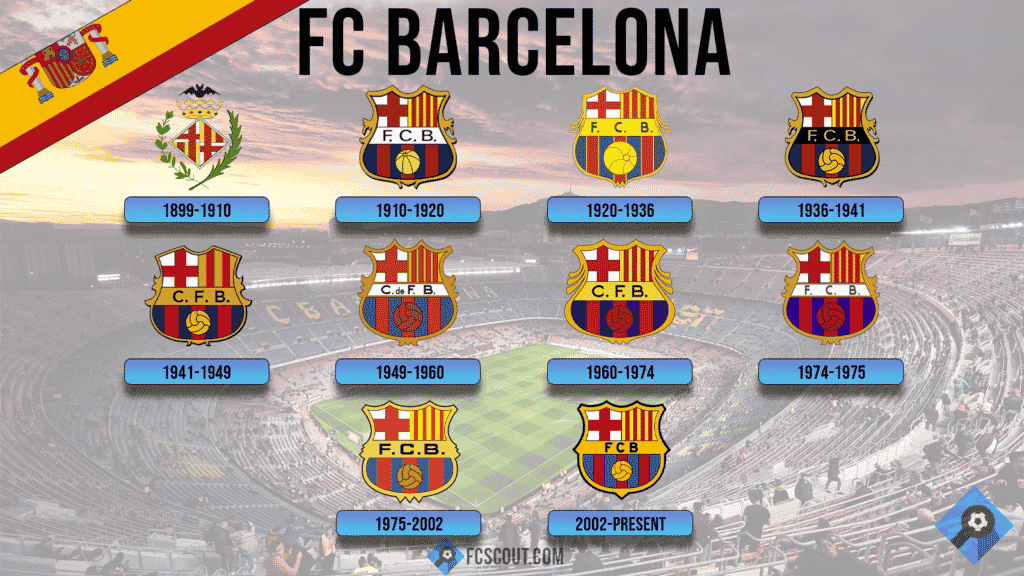FC Barcelona Crest
The team’s official logo has always been made up of four separate heraldic signs and various other symbols. Each of them embodies a distinct idea: the need for growth, occupation, reverence for the past, and intimate ties to the area of origin. The cross of St. George, the patron saint of Catalonia, may be seen in the upper left corner. The Catalan flag of Senyera is displayed there to the right, with four red stripes on a yellow background. A broad strip bearing the capital letter “FCB” extends below them. The entire name Football Club Barcelona is shortened to this. The lower portion, which features a yellow ball with three red lines on a blue field—the color of a football player’s uniform—is divided by black letters on a gold background.

With its black edging, a curvy medieval shield combines all the pieces. The blue-garnet hue of the business is the subject of three urban tales. Hans Gamper, the company’s founder, was unable to decide on the color of the uniforms. He had doubts about Ticino, a canton of his native Switzerland, and Excelsior, his first club. It is also reported that one of the attendees at a constituent assembly in 1899 had a two-sided blue-garnet pencil, which were common at the period.
The national colors of Catalonia are stripes of red and yellow. Four bands were changed to two during the reign of the fascist dictator Francisco Franco (1939–1975), since the Spanish flag has the same colors but fewer bands. The band was brought back in celebration of the club’s 50th anniversary at the end of the 1940s when political repression was at its weakest. Sans Serif, one of its variants, created by Tobias Frere-Jones, is the font used on the logo. Interstate Bold is the name of it.
FC Barcelona Logo History
Hans Gamper, a Swiss businessman, created Barcelona Football Club, usually referred to as Barça. He addressed a letter to a nearby newspaper on October 22, 1899, inviting everyone to take part in starting a football team. Eleven individuals answered, and on November 29, 1899, they established a team called FC Ball (Foot Ball Club Barcelona).
The club’s outfit had a blue-pomegranate hue from the moment the team was founded; the shirt’s blue half was contrasted with a pomegranate color on the other, and the pants were painted white. In 1910, the well-known Barcelona crest first emerged. Minor adjustments have been made to it up until this point. To underscore the club’s connection to the city, the coat of arms of Barcelona was first used as the foundation for the logo. However, the group ultimately decided to design their coat of arms.
The team has used various variations of the same logo over the years. The most significant and iconic dates back to the 1910th year. Its near-complete repetition in the alternatives for succeeding years illustrates the club’s persistent vision. The Barcelona coat of arms served as the club’s badge for the first 11 years of its existence, but in 1910, the club’s founder decided it was time to give his squad its own symbol. Carles Kampala, a team member and medical student, won the contest for the best insignia.
The symbol for Barcelona is the Saint George’s Cross, which represents the patron saint of Catalonia. The club management altered it for Muslim supporters in 2010 before securing an advertising contract with Qatar Foundation (worth $150 million). The horizontal strip was thus taken off. The ball from the early 20th century that is shown on the Barcelona sign is still in its original shape. The logo has undergone 12 small changes over its 105-year lifespan.
An attempt to modernize the club symbol was undertaken in 2018. Due to the lack of projecting components and an abbreviation, the new version of the logo appeared more concise than the previous ones. The borderlines of the ball’s hue were further strengthened by the Summa agency, who was entrusted with upgrading the logo, giving the ball a golden appearance. Additionally, a bright spectrum now dominates the overall color palette. The club members who were in charge of approving the alterations were shown this insignia. After a vote in October at the annual meeting of all members, the logo was rejected.
